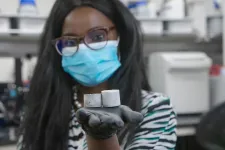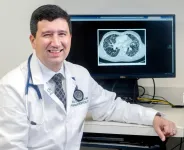Running in the blood: Blood lipids are linked to cancer, but depending on family history
Medical researchers identify the role of family history in the link between blood lipids and esophageal cancer
2021-06-21
(Press-News.org) Fat biomolecules in the blood, called "serum lipids," are necessary evils. They play important roles in the lipid metabolism and are integral for the normal functioning of the body. However, they have a darker side; according to several studies, they are associated with various cancers. The medical community has fathoms to go before truly understanding the implications of different serum lipid levels in cancer.
As a major step in this direction, a group of scientists from the Key Laboratory of Carcinogenesis and Translational Research, Laboratory of Genetics, Peking University Cancer Hospital and Institute; Hua County People's Hospital; and Anyang Cancer Hospital, have successfully determined that a family history of esophageal cancer modifies the association between serum lipids and risk of developing cancerous esophageal lesions, according to a pioneering study published in Chinese Medical Journal.
Many individuals undergo routine lipid profile checkups, but most people and doctors only focus on the risk of cardiovascular diseases, and unwittingly fail to look deeper into the results. What if the change in serum lipid levels is an sign of the risk of having malignant esophageal lesions?
To answer this question, Chinese medical researchers analyzed data from the "Endoscopic Screening for Esophageal Cancer in China" trial. The trial included analysis of serum lipids like total cholesterol (TC), triglycerides, low-density lipoprotein cholesterol (LDL-C), and high-density lipoprotein cholesterol from 211 individuals with malignant esophageal lesions, and 2101 "control" individuals who didn't have the lesion.
Although the team's initial analysis of data showed that there is no consistent association between serum lipid levels and risk of developing malignant esophageal lesions, a simple family history check--and deeper analysis--told a different story. Particularly for cases with a family history of esophageal cancer, high levels of TC and LDL-C were linked to a significantly higher risk of developing malignant esophageal lesions. Also, when such family history was not identified, there was a notable negative association between the same parameters. Better to know late, than never, right?
Professor Yang Ke from Key Laboratory of Carcinogenesis and Translational Research, Laboratory of Genetics, Peking University Cancer Hospital and Institute, Beijing, who is also one of the lead scientists of the study, thinks so. In this regard, Professor Ke jubilantly says, "We found that the association of serum lipids and malignant esophageal lesions might be modified by esophageal cancer family history. This finding provides population-level evidence in research at the interface of serum lipid biology and esophageal carcinogenesis."
Further, the findings of this study shed light on the importance of considering a 'stratified' analysis on such population-based studies. A relevant example is a stratification this study proposes, in terms of those with and without esophageal cancer family history. This stratification helped the researchers have a better understanding of the data from the trial considered. Moreover, Dr. Meng-Fei Liu, from Laboratory of Carcinogenesis and Translational Research, and the other corresponding author of this study, thinks that this research is far from its endpoint. He says, "The stratified analysis would be crucial for population-based studies investigating the association of serum lipids and cancer. However, the mechanism by which a family history of esophageal cancer modifies this association warrants further investigation."
Overall, this study has paved the way for a better understanding of the role of serum lipids in esophageal carcinogenesis in cases involving esophageal cancer family history. While the medical community continues to look for further advances, which could be translated into future clinical applications in such population-based cancer research, this study has definitely given us much to think about; the signs of cancer may be in our blood, in more ways than one!
INFORMATION:
Reference
Title of original paper: Family history of esophageal cancer modifies the association of
serum lipids and malignant esophageal lesions: a nested case-control study from the "Endoscopic Screening for Esophageal Cancer in China" trial
Journal: Chinese Medical Journal
DOI: https://doi.org/10.1097/CM9.0000000000001432
ELSE PRESS RELEASES FROM THIS DATE:
2021-06-21
(BOSTON) - Research collaborators from the VA, Boston University, and the Concussion Legacy Foundation (CLF) published an inspiring new report today, "1,000 Reasons for Hope," which exclusively details the first 1,000 brain donors studied at the VA-BU-CLF Brain Bank since 2008 and how they have advanced research on concussions and CTE. The report also explains how the next 1,000 brain donors will answer critical questions that take us closer to preventing, diagnosing, and treating CTE, as well as the long-term consequences of concussion and traumatic brain injury.
"Our understanding ...
2021-06-21
Johan Gaume, an EPFL expert in avalanches and geomechanics, has turned his attention to ice. His goal is to better understand the correlation between the size of an iceberg and the amplitude of the tsunami that results from its calving. Gaume, along with a team of scientists from other research institutes, has just unveiled a new method for modeling these events. Their work appears in Communications Earth & Environment, a new journal from Nature Research.
These scientists are the first to simulate the phenomena of both glacier fracture and wave formation when the iceberg falls into the water. "Our goal was to model the explicit interaction between water and ice - but that has a substantial cost in terms of computing time. We therefore decided ...
2021-06-21
An increasing number of studies on artificial intelligence (AI) are published in the dental and oral sciences but aspects of these studies suffer from a range of limitations. Standards towards reporting, like the recently published CONSORT-AI extension, can help to improve studies in this emerging field. Watch authors Falk Schwendicke and Joachim Krois of the Charité - Universitätsmedizin Berlin, Germany, discuss the Journal of Dental Research (JDR) article "Better Reporting of Studies on Artificial Intelligence: CONSORT-AI and Beyond," moderated by JDR Editor-in-Chief Nicholas Jakubovics, Newcastle ...
2021-06-21
When the COVID-19 pandemic hit during the winter of 2020, locking down entire countries and leaving people isolated in their homes without outside contact for weeks at a time, many relationship experts wondered what that kind of stress would do to romantic couples. What they found was that when couples blamed the pandemic for their stress, they were happier in their relationships.
The findings are outlined in a paper out today in the journal Social Psychological and Personality Science.
Previous research has shown that romantic partners tend to be more critical toward each other when experiencing ...
2021-06-21
Forces of nature have been outsmarting the materials we use to build our infrastructure since we started producing them. Ice and snow turn major roads into rubble every year; foundations of houses crack and crumble, in spite of sturdy construction. In addition to the tons of waste produced by broken bits of concrete, each lane-mile of road costs the U.S. approximately $24,000 per year to keep it in good repair.
Engineers tackling this issue with smart materials typically enhance the function of materials by increasing the amount of carbon, but doing so makes materials lose some mechanical performance. By introducing nanoparticles into ordinary cement, Northwestern University ...
2021-06-21
TAMPA, Fla (June 21, 2021) -- A blood gene profile associated with a high risk of dying from a severe lung disease can also predict poor outcomes in patients with COVID-19, a multicenter retrospective study led by the University of South Florida Health (USF Health) demonstrated. The risk profile based on 50 genes could help customize how COVID-19 is treated, improve allocation of limited health care resources such as intensive care beds and ventilators, and potentially save lives.
Idiopathic pulmonary fibrosis (IPF), a disease of unknown cause, affects the lung interstitium or the space between the lung sacs and the bloodstream, leading ...
2021-06-21
UNIVERSITY PARK, Pa. -- Using solar energy to inexpensively harvest hydrogen from water could help replace carbon-based fuel sources and shrink the world's carbon footprint. However, finding materials that could boost hydrogen production so that it could compete economically with carbon-based fuels has been, as yet, an insurmountable challenge.
In a study, a Penn State-led team of researchers reports it has taken a step toward overcoming the challenge of inexpensive hydrogen production by using supercomputers to find materials that could help accelerate hydrogen separation when water is exposed to light, a process called photocatalysis.
Both electricity and solar energy can be used to separate hydrogen from water, ...
2021-06-21
Sperm size varies dramatically among different animal species. But why is sperm size so variable when they share the same job - to fertilize eggs? In a new article published in Nature Ecology and Evolution, researchers from Stockholm University show that animal sperm evolution become supercharged only when sperm swim inside females.
Sperm are the most variable cell type known, ranging in size from 0.002 millimeters in a freshwater rotifer to nearly 6 centimeters in a fruit fly. Explaining why sperm are so variable has been a major focus in evolutionary ...
2021-06-21
One in three patients who dies in a hospital has sepsis, a severe inflammatory response to an infection, marked by organ dysfunction, according to the Centers for Disease Control and Prevention. This heavy toll makes predicting which patients are at risk for developing the devastating condition a top priority for clinicians.
Additional motivation to identify and treat sepsis cases lies in the fact that sepsis serves as a system-level quality measure, with hospitals judged by both the by the federal Department of Health and Human Services and the CDC on their sepsis rates. Complicating efforts to reduce sepsis is how difficult it can be to diagnose--both accurately and quickly.
"Sepsis is something we can ...
2021-06-21
(COLUMBUS, Ohio) - According to the American Burn Association, burn injuries affect approximately 250,000 children in the United States each year. The pain associated with burn injuries extends beyond the injury itself; there is also significant pain from dressing changes, which can be exacerbated by the anxiety of anticipating this additional pain.
Although opioids relieve burn injury-related pain, they have serious adverse side effects. Prior studies have investigated alternative approaches to pain reduction in burn injury patients that focus on distraction, such as music, hypnosis, toys, and virtual reality (VR).
In a study published today in JAMA Network Open, Henry Xiang, MD, MPH, PhD, MBA, and his research team reported the ...
LAST 30 PRESS RELEASES:
[Press-News.org] Running in the blood: Blood lipids are linked to cancer, but depending on family history
Medical researchers identify the role of family history in the link between blood lipids and esophageal cancer

